At 707m, the Burj Dubai is finally nearing its summit. But how do you go about building such a giant – and how do you ensure it doesn’t topple over in a high wind or an earthquake? Thomas Lane went on site at the world’s tallest tower
Kyung-Jun Kim is in the unusual position of having built the world’s tallest building – twice. He was the project director on the Petronas Twin Towers for Samsung, the contractor. They were the world’s tallest buildings when they were completed in 1998. But that is a mere pipsqueak compared with Kim’s latest project, the Burj Dubai. The Petronas towers are 452m tall including the spire; the Burj Dubai’s final height is a secret but will be more than 700m when it is completed next year.
Kim dismisses comparisons between the two buildings because they are so different. The Burj Dubai has an almost entirely concrete structure whereas Petronas contains steel as well. The weather is very different in Dubai and of course there is that difference in height. “It’s a big challenge,” says Kim. “There were many questions about the structure, technical questions including the high-strength concrete and the contractual risk, because nobody has ever done this before.”
Forward planning
The project team at Samsung spent a year planning the job. During this time they worked out how they were going to construct the building, and in what sequence. The key to the Burj Dubai is its concrete structure. “It was the best solution from the usability, maintainability, constructability and cost point of view,” says Greg Sang, client Emaar’s project director. The high-strength concrete that has been used underwent thorough testing to ensure it would perform as intended. The mix had to be capable of being pumped up to 600m – above that height, the structure is all steel.
The downside of the high-strength concrete was that all of the 125,000 openings needed in the structure had to be carefully planned as it would be impossible to cut them out afterwards. Co-ordinating this was easier for Samsung, as Skidmore, Owings & Merrill (SOM) had done the architecture and engineering and was responsible for delivering 5,000 detailed construction drawings.
Careful planning has also been the key to the project’s success during the construction phase. “It takes a while to fully design a building like this,” says Sang. “For the past few years it’s been a matter of feeding the contractor information. There are lots of design issues that have to be resolved continually.”
As the Burj Dubai is the first of its kind, a lot of the equipment had to be created especially for it. Formwork had to be designed and made for the structure, and the cranes were also specially made and wind-tunnel-tested because of the building’s height. The cranes have lifting cables 900m long that weigh five tonnes.
Simply maintaining communications on a project of this scale was also an issue, Sang says. “The consultants are scattered all over the world so there are lots of conference calls and meetings. There are logistics issues, scheduling, contractors’ hoist times, and materials come in 24 hours a day materials are coming in, especially at night when work is a bit slower.”
If someone gives you a shove you will tip over onto one leg, but if you have a bag of cement on your shoulders, you won’t budge
William Baker, SOM
Working at height
The project’s tight schedule meant that the tower had to be constructed as quickly as possible. “When we were doing our planning, the original construction period was 47 months, so we decided the floors had to be constructed on a three-day cycle,” says Kim.
The sequence goes like this: on the first day, prefabricated rebar cages are lifted up and positioned and the embedded steel plates and shuttering for openings in the structure are located. On the second day the formwork is closed, ready for the concrete, and on the third day the concrete is pumped into place, an operation that takes place at night owing to the high temperatures in Dubai. After 12 hours the formwork is stripped and jacked up to the next level ready for the process to start again. “We had to resolve a lot of issues to make it an easy operation,” says Kim.
The building’s height ruled out traditional surveying equipment. “You can’t see through surveying instruments because of all the dust in the air,” says Kim. GPS was used to ensure the lift shafts were constructed within a tolerance of 25mm to accommodate the 54 elevators inside the building. “If the elevator shaft is out of tolerance, it means we have to correct it by chipping away the concrete,” says Kim. The shafts have in fact ended up within a tolerance of 3mm and Kim says Otis, the elevator maker, was “very surprised” at the level of accuracy. Amazingly, nearly everything was working out to plan.
The best laid plans
However, all this careful groundwork could not prepare the team for a piece of bad news that came in February 2006. The cladding contractor Schmidlin filed for bankruptcy just two months before it was due to start work. “It’s a major contract and very important for the completion of the project, so we knew we had to take action pretty quickly and positively,” says Sang. He adds that there were not many companies capable of supplying a bespoke, unitised cladding system for a building like the Burj Dubai. A saviour came in the form of Hong Kong firm Far East Aluminium.
The contract was signed in December 2006 and the first cladding panels were being hung in May 2007. “I’ve never seen anything like it,” says architect Eric Tomich. “Between late December and April they were able to design, press and test the cladding extrusions, which is a pretty spectacular performance.”
But the cladding was still a year behind schedule, and by now a huge 125-storey concrete structure was rising out of the desert without any sign of its glass skin. How could the team make up the lost time? The building design coupled with the speed of the cladding production facility came to the rescue. Normally the cladding starts at the bottom of a tall building and works up the structure, and on the Burj Dubai the cladding has an interlock that means the panels can only be installed going up, not down. Because the Burj Dubai has three plant room floors over its height, these provided a natural break point, which meant the cladding contractor could work on three fronts at once. “Within a year we had clad 140 levels. This method was very successful,” says Kim.
We were very lucky that we completed the concrete structure when we did. At the beginning of the year the price of concrete almost doubled
Kyung-Jun kim
Finishing touches
Now the cladding is largely done, fit-out work is well under way inside. According to Sang, virtually every type of specialist contractor is now working on the tower, with a total of more than 8,000 workers. Getting all these on site every day is a big operation. “During the morning we try and stagger the subcontractors and only use the hoists for moving people,” says Sang. “After 10am it’s back to moving materials.” People are kept in the building during the day; there are two canteen levels inside the building and toilet facilities on every two floors.
As the fit-out teams work on the hotel at the building’s base and the apartments above, the tower still climbs towards the sky. At level 156, the structure changes to steel. This was not in Samsung’s original contract so the programme has been extended from the end of this year to September 2009 and a new price agreed for the extra work. Kim says strong winds meant that not much got done during the first quarter of this year so a special wind shielding system has been made by formwork specialist Doka, the firm that
did the formwork for the concrete structure. Now time is being made up on the steelwork by working on Fridays, a public holiday in Dubai, and by carrying out welding work at night.
A cut above?
Now that the difficult technical part of the project is out of the way, what does the team think about the rash of pretenders threatening to topple the Burj Dubai from top spot? “There’s a lot of talk, but nobody has done it,” says Tomich. “It’s difficult to do, you have to hit the market at exactly the right time. Emaar pressed the button at just the right moment and tendered at the right time. Anyone doing it now will find it much more expensive to build, with less skills and resources.”
Kim agrees: “I believe we were very lucky that we completed the concrete structure when we did. At the beginning of the year the price of concrete almost doubled, but we had completed the concrete works.” As it was, the team had to scour the world to find the materials to keep the project going.
And how would Kim feel about building the world’s tallest building three times?
“Why not?” he smiles. “I am personally very lucky to have built the tallest tower in the world twice. Maybe I will get to build another one.”
Engineering the world’s tallest building
Originally the Burj Dubai was going to be only a snip taller than the existing record holder, the 509m Taipei 101 skyscraper in Taiwan. “We designed it to be just a little bit taller than Taipei 101. We didn’t want to promise anything until we had done the wind tunnel testing,” says William Baker, structural engineering partner at Skidmore, Owings & Merrill (SOM). But that was enough to secure the Chicago-based architect and engineer the job of designing the tower. Baker was confident his design could go a lot taller than Taipei 101. SOM had already used the design on a building in Korea. “It was quite obvious to us we could go very high with this design,” he says.
Tall buildings have to be capable of coping with significant lateral forces, namely strong winds, and in the case of the Burj Dubai, seismic forces too, but the tower was planned with this in mind. The design is elegantly simple. It has a single core, buttressed by three shear walls extending from, and spaced equally around the core in a “Y” configuration.
This tripod-style design is not only good at resisting lateral forces, it is also an ideal arrangement for a tall residential building. The depths of residential buildings are limited by the need to get natural light into all rooms. The most efficient shape to achieve this is a rectangular block, but this is not a good shape for a tall building as the long side acts as a giant sail, and its narrowness means it is structurally weak.
With SOM’s solution, each of the three sections protruding from the core is rectangular and is buttressed by the other two sections through the core. Each of the rectangular sections consists of two parallel walls separated by cross walls which helps spread the loads evenly over the foundation.
The core is hexagonal as this is a good shape for resisting the twisting forces generated by the wind. It is also the same size all the way up the building, which makes it simpler to construct. Baker says that this was vital as there was no contractor on board while the building was being designed. “It had to be relatively easy to build by a number of players so we went for fairly conventional components arranged in an unusual way to give the most efficient solution.”
SOM found that by tweaking this arrangement of components they could go much higher than their original proposal as the design became more and more stable, and capable of resisting the wind forces. “It was a continual exploration as we were going where nobody had gone before,” says Baker. “We did a lot of wind tunnel testing and refining of the structural system. As we understood it more and more and changed things, we found the degree of motion the building was subject to dropped.”
Baker says that the final solution they found would move less than the original proposal despite it being 200-300m taller. The building is predicted to move at the top by up to a metre but Baker says this movement will be slow enough for it to be barely perceptible.
Minimising movement has been helped by the way the building steps back as it gets taller. Each of the three rectangular sections steps progressively up the building, which gives the tower its elegant rocket shape.
These have been positioned to help “tune” the building’s natural frequency so it is different from the wind frequency, which keeps the movement of the building within controllable limits.
Baker is also pleased that he has managed to minimise the amount of steel rebar needed in the reinforced concrete structure. “The foundation slab has the same amount of rebar in it as a slab for a 30-to-40-storey building,” he says proudly. This has been achieved by ensuring the structure stays in compression – rebar is only needed to resist tensile forces. He says this has been done by using the natural weight of the building to cancel out the effects of the wind. “If someone gives you a shove you will tip over onto one leg, but if you have a bag of cement on your shoulders, you won’t budge,” he says.
The structure is built from concrete partly because it is primarily residential and concrete is ideal because it is naturally fire resistant and has good acoustic performance. Greg Sang, Emaar’s project director adds that concrete can simply be pumped into place whereas steel relies on tower cranes. “We don’t think that we could have built this building as fast if it had been built from steel because of the danger of the cranes not being able to operate because of the wind.”
Factfile
The world’s tallest building is now over 707m high.
111,500m2 of cladding, enough to cover 17 football fields
A cooling system that will collect enough water to fill 20 Olympic-sized swimming pools each year, and which will be used to irrigate the landscaped areas
31,400 tonnes of rebar. Laid end to end this would extend one quarter of the way around the world
230,000m3 of concrete, which would create a solid concrete cube 61m tall, long and wide
Enough cooling power to create 12,750 tonnes of ice each day
Enough power to light up half a million 100W lightbulbs at the same time
Servicing the Burj
The Burj Dubai’s height meant an unusual services strategy had to be adopted.
For a start, the air temperature is much lower at the top than at the bottom. “With HVAC designs you typically design from one set of data,” says Roger Frechette, Skidmore, Owings & Merrill’s M&E engineer. “Here the temperature can vary by as much as 11°C.” The services also needed to be as compact as possible to minimise the amount of space they took up in the core.
The solution was to create a service floor every 40 storeys. This will provide cooled air tuned to the temperatures outside that part of the building.
It will also contain a substation to reduce the electrical supply voltage for that part of the building. If electrical cables supplying main voltage power to the whole tower were used these would have to be very thick. “Because you are running at a higher voltage the cables can become much smaller and it’s more efficient,” says Frechette.
Each service floor also contains water tanks to allow water to be pumped up the building in stages. “It would be virtually impossible to pump water from the bottom of the building to the top as there is no equipment available that can do that,” says Frechette.
A similar strategy has been adopted for the lifts. Express lifts will go from the ground and serve levels 43, 76, and 123, local lifts will serve the floors below and above these.
The final issue that had to be resolved was the stack effect of warm air rising inside shafts in the building. “You get very high velocities inside the shafts, which cause all sorts of problems like noise and not being able to open doors,” says Frechette.
The solution was to fit seals around the elevator doors to reduce this effect, and there are alarms inside the apartments designed to dissuade residents from inadvertently creating pathways for air flow. These sound if residents open a balcony door and the door to their apartment at the same time.
For more international projects, news, comment and analysis, go to www.building.co.uk/global
Project team
Client Emaar Properties
Architect, structural and M&E engineer Skidmore, Owings & Merrill
Supervising engineer Hyder Consulting
Wind consultant Rowan Williams Davies & Irwin
Project manager Turner International
Contractor Joint venture between Samsung, Besix and Arabtec
Piling Bauer Spezialtiefbau/Middle East Foundations foundation slab Nasa Multiplex
Cladding Arabian Aluminium/Far East Aluminium
Lifts Otis
Downloads
Plan of Burj Dubai
Other, Size 0 kb




















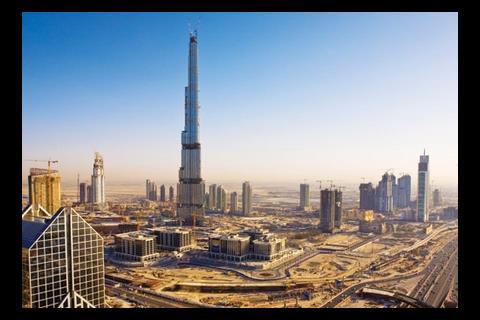


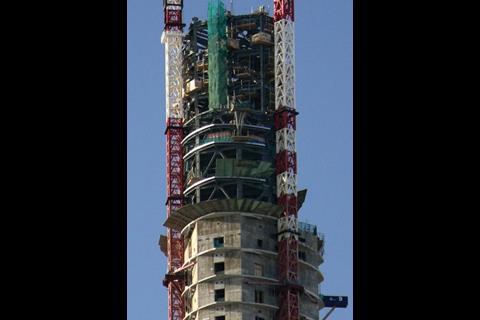
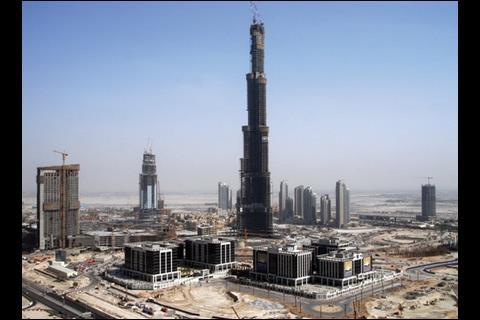


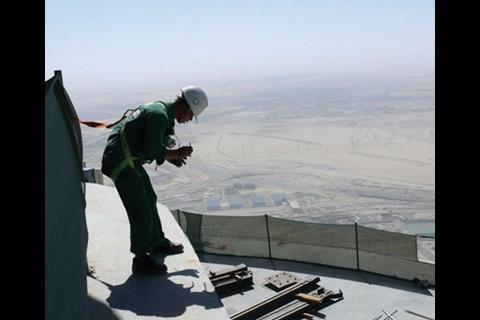

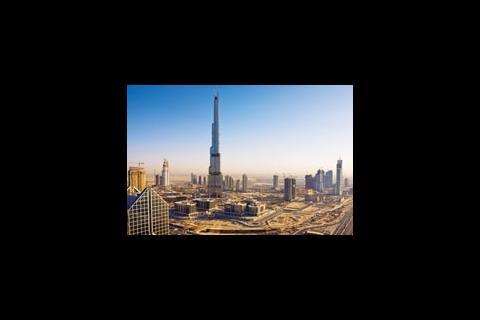







3 Readers' comments